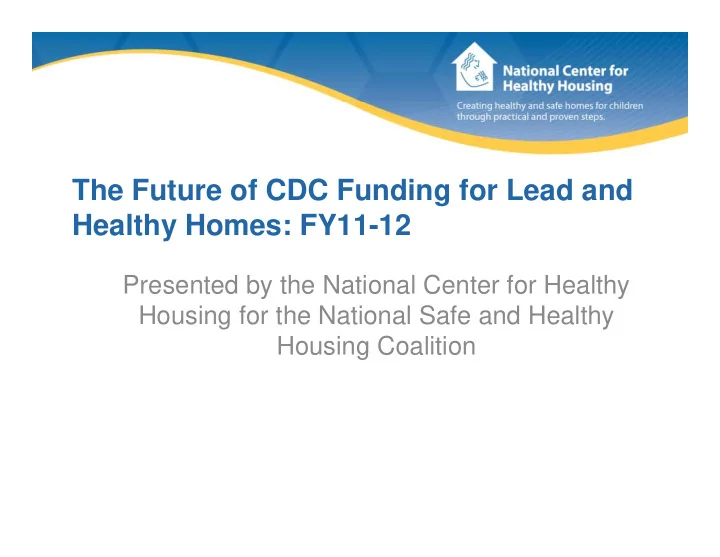

The Future of CDC Funding for Lead and Healthy Homes: FY11-12 Presented by the National Center for Healthy Housing for the National Safe and Healthy Housing for the National Safe and Healthy Housing Coalition
Call Purpose/Objectives: Call Purpose/Objectives: •Brief community based organizations and other advocates on status of FY11 and FY12 funding from CDC for lead and on status of FY11 and FY12 funding from CDC for lead and healthy homes •Summarize advocacy strategies underway y g y •Review of advocacy/lobbying options and targets •Review draft messages Review draft messages •Discuss state and local implications of proposed cuts •Outline next steps & opportunities for collaboration •Outline next steps & opportunities for collaboration
FY11 Continuing Resolutions • House CR (HR 1) – proposed 23% cut to CDC – Program-specific cuts not defined • Senate – Rejected both HR 1 and Senate Senate Rejected both HR 1 and Senate Democrats’ alternative • Current CR runs out March 18 • Current CR runs out March 18 – Cuts still a possibility
FY11 Grants to States • 33% limit on funding retained by states (unless through a non-profit agency) • 50% reduction in max award amount • Second year of funding likely impacted by President’s budget if it passes Congress President s budget if it passes Congress
FY 12 (President’s Budget) ( es de t s udget) • Overall reduction for Environmental Health ($43 289 000) ($43,289,000) • Eliminates built environment activities ($2 683 000) ($2,683,000) • Reduces both asthma and CLPPP/Healthy H Homes (by $33,045,000) (b $33 045 000) • Creates “Healthy Home and Community Environments program”
Healthy Home and Community y y Environments Program • Program includes “ surveillance, partnerships, g , p p , and implementation and evaluation of science- based interventions to address the health impact of environmental exposures in the homes and to reduce the burden of disease through comprehensive asthma control ” comprehensive asthma control - FY2012 CJ FY2012 CJ Performance Budget • CDC will take 2 years to transition to this • CDC will take 2 years to transition to this approach
Consolidation • Implications – Reduce National Asthma Control Program funded R d N ti l A th C t l P f d d states from 36 to 15 or fewer – Reduce funded recipients from 40 to 34 to implement Reduce funded recipients from 40 to 34 to implement Healthy Homes programs • Eliminate cities’ grants. g – CDC will no longer provide funding support to maintain HHLPSS. States which adopt the system will b be required to support it. i d t t it
Consolidation • Not necessarily a done deal • Asthma groups not on board with A th t b d ith consolidation. • Needs more thoughtful plan. • Not clear how clinical and school Not clear how clinical and school component of asthma program fit. • Impossible to gain 50% in efficiencies. I ibl t i 50% i ffi i i
Implications of the Cuts Implications of the Cuts Work that will not get done Economic impact • Decline in abatement orders Decline in abatement orders • Jobs lost Jobs lost • Decline in cases followed or managed • Public Health Capacity Lost • Targeting not possible without data • Long-term cost to health (impacts HUD Program) care, school systems • Trend reporting lost, including attention to emerging sources of lead to emerging sources of lead • RRP tracking/outreach eliminated • WIC-HS-other programs not reached p g • No primary prevention
NCHH and Others’ Advocacy Efforts y • Letter sent to all House members and Senate members re: FY11 (H.R. 1) • National advocacy calls held with asthma program non- governmental organizations’ representatives to develop collaborative message and strategy ll b ti d t t – Joint letter to HHS Secretary drafted • Met with CDC leadership re: FY12 M t ith CDC l d hi FY12 • Reached out to some key Congressional offices • Parents of lead-poisoned children – ALPHA letter
Suggested Advocacy Activities gg y • Call, write, email, visit your Senators & Representatives – Appropriations Committees’ Labor HHS subcom = priority – Appropriations Committees Labor HHS subcom. = priority • Tell Governor’s office cut will create new problems. • Mobilize lead advisory committees CLPPP partners • Mobilize lead advisory committees, CLPPP partners – ask CLPPP staff for suggestions of contacts • Reach out to managed care home visiting school board • Reach out to managed care, home visiting, school board • LBP activities professionals and trainers • Parents of lead poisoned kids Parents of lead poisoned kids
Other Implications of Cuts Other Implications of Cuts and Advocacy Opportunities • Group Discussion
Action Plan & Next Steps • Contact Senators and Representatives – Priority – members of appropriations • Reach out to all possible allies • Watch http://capwiz.com/nchh/home/ & leadnet p p – Inform parents of lead-poisoned children about ALPHA sign on – alphalead@comcast.net
Contact Information J Jane Malone, Policy Director, NCHH M l P li Di t NCHH jmalone@nchh.org 202.580.7203 Rebecca Morley, Executive Director, NCHH y rmorley@nchh.org 443.539.4159
Recommend
More recommend